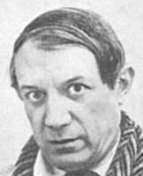Skip to: site menu | section menu | main content
Welcome To Democracy And Socialism .Com
Things should be made as simple as possible, but not any simpler- Albert Einstein
Pablo Picasso (1881 -1973) |
 |
Picasso was as famous as no artist ever had been; he was a pioneer, a master with a hand in every art movement of the century. In real life he was a lifelong communist and humanist.
Pablo Ruiz Picasso was born in Malaga-Spain. His parents where far from rich; with their three children it was often difficult for them to make a relatively easy life. Pablo’s talent in painting first was recognized by his father who taught drawing at the schools. Later they moved to the city of Coruna to seek a better life, then to Barcelona, Madrid and again to Barcelona.
Picasso’s first works were in “classicism”, but he was very enthusiastic about new directions in art, he said fare-well to “classicism” and started his enduring search and experiment
In 1907 he painted his first cubistic picture. After cubism he returned to more traditional patterns, but not exactly the classic ones, this style called “Classicist Style”. But from time to time he returned to cubism.
When the civil war of 1936-39, broke out in Spain, he supported the legitimate Republican Government against the fascist rebels. The complete destruction of Guernica, the oldest town of the Basque and the massacre of the people there by the fascists and their ally, Nazi Germany’s Air-force, had a great impact on him which he depicted in his gigantic mural Guernica.
After the liberation of Paris from the Nazi occupiers in 1944, he was there and rejoined the Communist Party of France, and became an active participant of peace movement. In 1950 and in 1961 (For the second time) he was awarded the Lenin Peace Prize.
He protested against the 1950-53 invasion of American imperialism and its allies in Korea. He was also against the Soviet invasion of Hungary in 1956. He believed that socialism must be built by the people themselves and not be imposed by outsiders even if they are socialist powers. But he never abandoned his believes and remained a loyal member of the Communist Party until his death.
He created a vast collection of art pieces which we can only show a sample:
-
The Barefoot Girl, 1895
-
The First communion, 1895-96
-
Science and Charity, 1897
-
Death of Casagemas, 1901
-
The life, 1903
-
Woman with a Crow, 1905
-
La Toilette, 1906
-
Guitar, 1913
-
Olega, 1917
-
Pierrot, 1918
-
Mother and Child, 1921-22
-
Three Musicians, 1921
-
Woman with a Flower, 1932
-
Dor Maar, 1937
-
Guernica, 1937
-
The Charnel House, 1944-45
-
Jacqueline in the Studio, 1956
-
Las Meninas, 1957
-
Luncheon on the Grass, 1961
-
Self Portrait, 1972